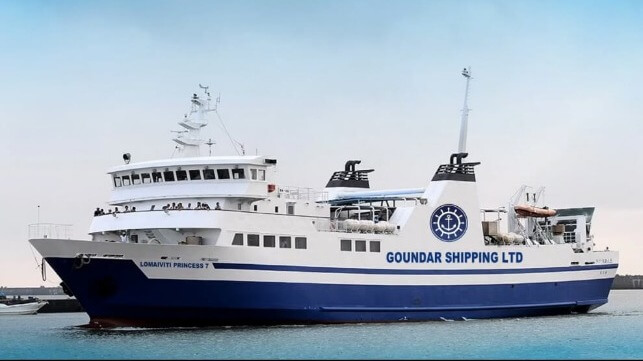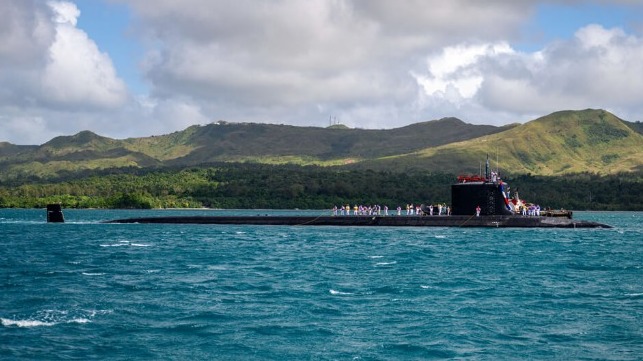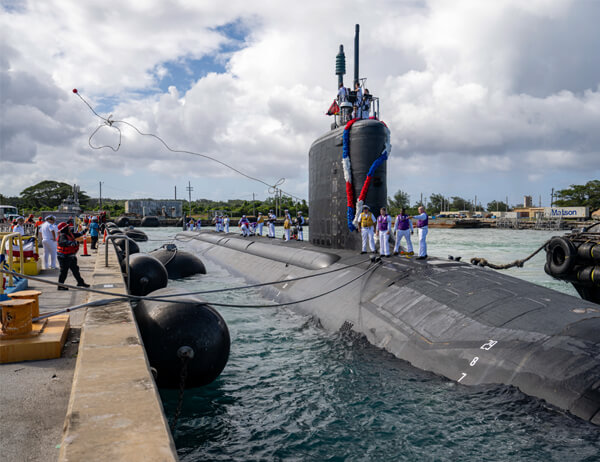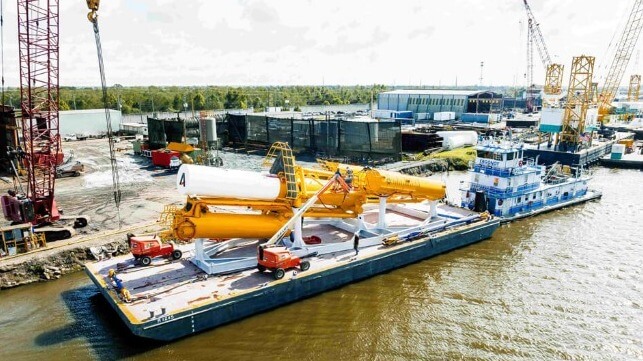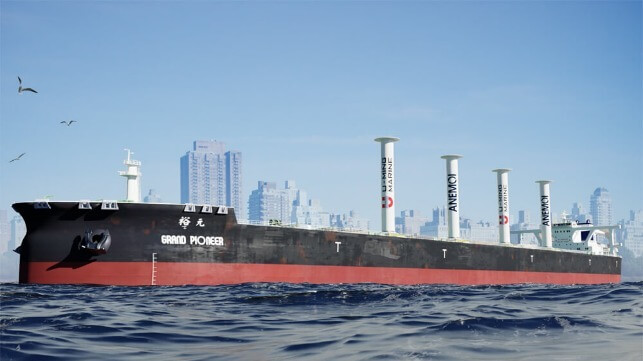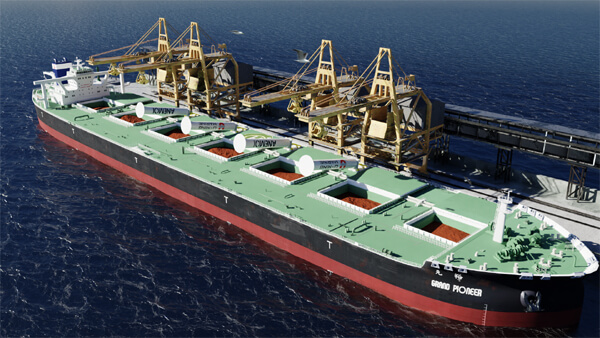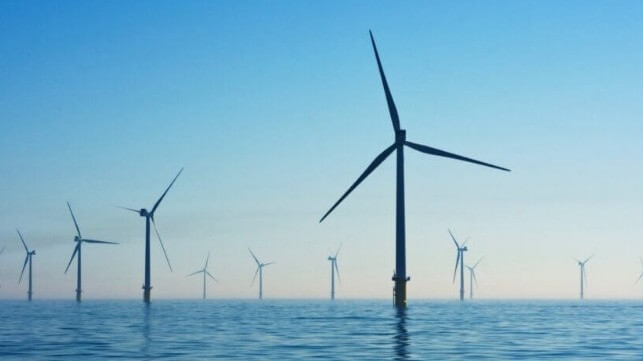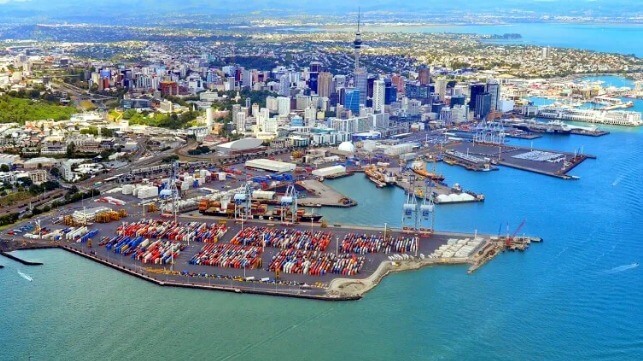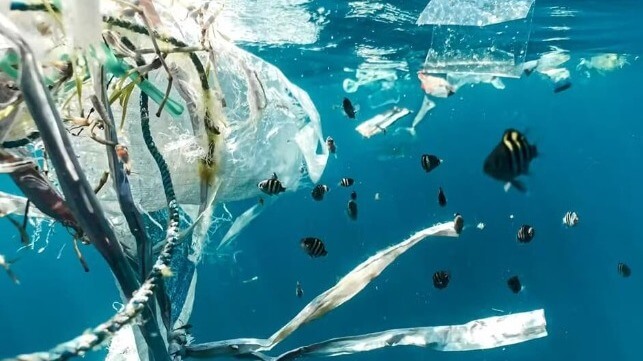ALT. FUELS
Maersk Names Next Methanol Ship for Founder A.P. Møller
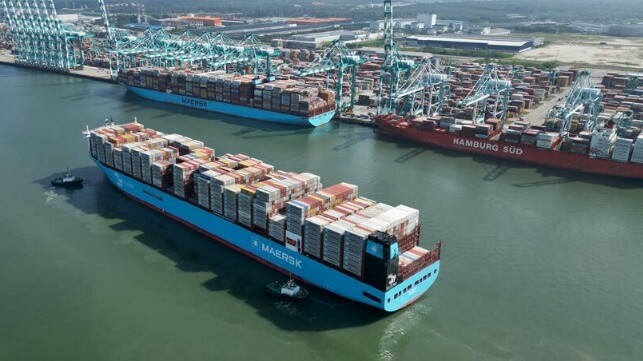
The rollout of Maersk’s dual-fuel methanol containerships continued with the naming ceremony in Singapore for the A.P. Møller. The vessel, which is the ninth in the line’s fleet able to operate on methanol was named in honor of Arnold Peter Møller, founder of the company.
A.P. Møller (174,000 dwt) is part of the series of 18 large dual-fuel methanol vessels being built for Maersk and scheduled for delivery in 2024 and 2025. Built at Hyundai Heavy Industries in Ulsan, South Korea, she can carry 16,592 TEU. Maersk reports she is the seventh of these large dual-fuel methanol vessels to join the Maersk fleet in 2024, following sister ships including Ane Maersk which was the first of the class which was named in January. Others include Astrid Maersk, Antonia Maersk, Alette Maersk, and Alexandra Maersk.
The newest vessel of the class, A.P. Møller departed from Ningbo, China on November 16 to start her maiden voyage. She has made stops in Shanghai, Nansha, and Yantain, China before arriving on November 27 in Singapore. She is due to depart on November 29 with her next scheduled stops in Malaysia and Sri Lanka. Ms. Chan Su-Shan, the wife of the CEO of Temasek Holdings was the godmother of the vessel during the ceremony on November 28.
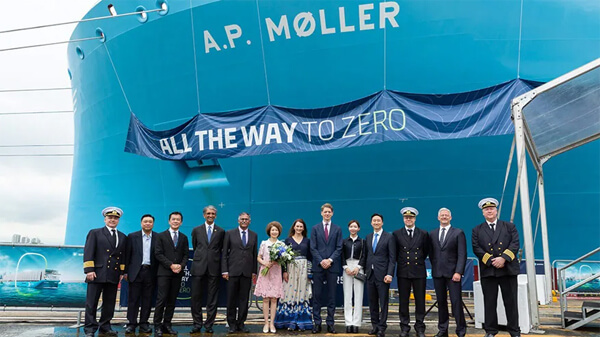
Naming ceremony for the newest vessel took place in Singapore during its maiden voyage (Maersk)
“Today marks a significant milestone in our journey of decarbonizing the maritime industry,” said Murali Pillai, Minister of State, Ministry of Law and Ministry of Transport in Singapore during the naming ceremony. “The arrival of A.P. Møller in Singapore not only showcases the advancements in shipping technology but also reinforces our commitment to support solutions that can reduce greenhouse gas emissions.”
Singapore officials highlighted that the port also conducted the inaugural ship-to-containership methanol bunkering for the Laura Maersk in July 2023. The feeder ship was the first introduced built to operate on methanol. Maersk also recently completed the first conversion of an in-service containership to dual-fuel methanol capabilities.
The delivery of the dual-fuel fleet Maersk highlights as a significant component of its decarbonization goal of achieving net-zero greenhouse gas (GHG) emission by 2040. During a press briefing in Singapore, Maersk told reporters that alternative fuel last year accounted for just three percent of the approximately 10 to 11 million metric tons of fuel it uses each year.
The line projected its alternative fuel use would probably rise to between 15 and 20 percent by 2030. They noted that however, the fuel strategy anticipates that it will be using a combination of biodiesel, green methanol, and bio-methanol. They have discussed the supply concerns for alternative fuels while again emphasizing the price gap and the need to support the transition to alternative fuels.
The new vessel, A.P. Møller reportedly loaded 500 metric tons of green methanol before it departed the HD Hyundai Heavy Industries shipyard earlier in the month. The new large dual-fuel vessels have the capacity to carry 16,000 cubic meters of methanol for a trip from Asia to Europe and back to Asia. The vessels are powered by MAN dual-fuel engines.
Hapag-Lloyd Follows Maersk with Large Methanol Supply Agreement from China
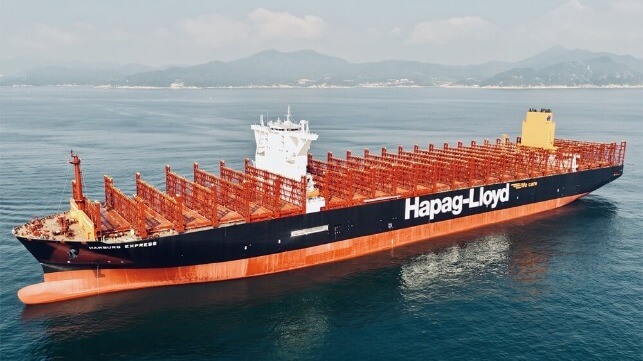
Hapag-Lloyd Follows Maersk with Large Methanol Supply Agreement from China
Germany shipping major Hapag-Lloyd reports it has completed a long-term supply agreement with Chinese energy company Goldwind to ensure a source of green methanol for the long-term power of its vessels. The deal comes almost a year after its soon-to-be partner Maersk completed a similar supply deal with Goldwind.
The new agreement is for the delivery of 250,000 tones of green methanol per year to Hapag-Lloyd. It will consist of a blend of bio- and e-methanol, ensuring greenhouse gas emissions reductions of at least 70 percent according to Hapag. As a company, Hapag-Lloyd aims to reduce the absolute GHG emissions of the fleet by around one-third compared to 2022. Compared to conventional fuels, the company reports the ordered quantity of green methanol can save a total of up to 400,000 tonnes of CO2e emissions in fleet operations per year.
“With the agreement, we are securing a significant proportion of our requirements for green fuels,” said Rolf Habben Jansen, CEO of Hapag-Lloyd. “This will bring us an important step closer to our goal of achieving net-zero fleet operations by 2045. It is and remains our ambition to play a leading role in the transformation of the liner shipping industry.”
Hapag is set to launch its new cooperation called Gemini with Maersk. Both companies have ambitions to be at the forefront of the transition and now both have long-term supply agreements with Goldwind. In November 2023, Maersk signed an offtake agreement calling for annual volumes of 500,000 tons of green methanol. At the time, Maersk called it the first large-scale green methanol offtake agreement for the global shipping industry.
Early volumes of the supply are expected to begin in 2026. Goldwind also plans to build a new green methanol factory adjacent to its existing project in Hinggan League, in northeast China. Goldwind plans to produce the fuels utilizing wind energy.
“The planned new factory will share technology, utilities, facilities, and infrastructures with its neighboring sister plant, boosting production efficiency,” said Liu Rixin, Head of Goldwind Green Methanol. It is still subject to the financial investment decision of the Goldwind board. We anticipate the completion of a megaton green methanol base in Hinggan League in late 2027.”
Maersk highlights the supply will be critical for its fleet of dual-fuel methanol containerships that it is in the process of rolling out. The seventh vessel was named today in Singapore.
Hapag earlier in the month announced a massive $4 billion investment in 24 new vessels. The orders include a dozen 9,000-TEU vessels from New Times Shipbuilding and a dozen 17,000-TEU vessels from Yangzijiang Shipbuilding. The company this month also marked the delivery of number eight in a series of 12 large, 23,660 TEU, LNH containerships being built by Hanwha Ocean (formerly Daewoo) as part of its fleet transition plan. Hapag also converted one in-service vessel starting in 2020 to LNG and recently announced a plan with Seaspan to convert five 10,100 TEU containerships on long-term charter to dual-fuel methanol operations starting in 2026.
Gasum has also agreed to provide Hapag-Lloyd with bio-LNG to fuel containerships sailing between Singapore and Rotterdam in 2025 and 2026. The supply that will meet Hapag’s obligation under its contract with the cargo owners project, ZEMBA, where it won the first bidder for a volume of low-carbon shipping from the buyers alliance that unites major shippers including Amazon, Patagonia, Bauhaus, New Balance, Nike, REI, and others. Gasum will bunker Hapag-Lloyd’s containerships with a total amount of 20,000 mt of bio-LNG during 2025-2026.
Copenhagen Infrastructure Partners Plans Ammonia Shipping Newbuilds
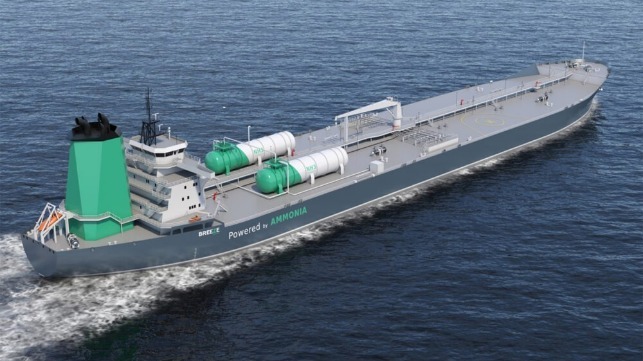
The well-known Danish fund manager Copenhagen Infrastructure Partners (CIP) which focuses on renewable energy investments is moving forward to develop ammonia-fueled carriers to lead in the energy transition. Its Energy Transition Fund entered into agreements with Norwegian shipping company Faerder Tanks and with Singapore-based BW Epic Kosan to develop one of the first fleets of ammonia-fueled ammonia carriers with a goal of launching an end-to-end solution for ammonia to be used by the shipping industry.
CIP is a leader in segments of the energy transition well-known for its investments in wind energy as well as pioneering projects in hydrogen and industrial-scale Power-to-X projects. The investment group is pursuing ammonia production with facilities to be located in Australia, South America, and Mexico and now looks to connect the supply and demand with a fleet of ammonia carriers. The goal is to deliver comprehensive, end-to-end solutions for ammonia-fueled tankers, promoting the green transportation of clean ammonia.
“Our objective is to facilitate the green transportation of clean ammonia by utilizing the cargo as fuel,” said Niels H. Lindegaard, Senior Business Advisor at CIP. “The dialogue with leading companies has given us valuable industry insights and the ability to develop safe and robust end-to-end bunkering solutions as well as first-hand knowledge about critical developments and maturity of solutions.”
Working with Faerder Tanks, CIP has entered into a Memorandum of Understanding to develop a 50,000 cmb ammonia carrier. CIP reports the vessel will feature high maneuverability and ship-to-ship bunkering capabilities, setting a new standard for medium gas carriers (MGCs). The first vessel, expected to join the fleet in the second half of 2028, is based on the successful MGC sector which they highlight has become a workhorse of the shipping industry.
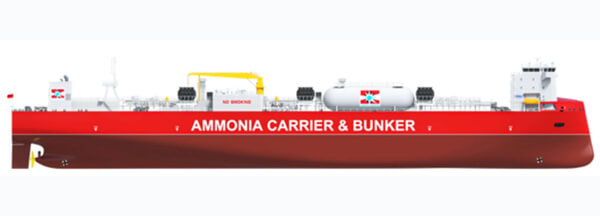
Faerder Tankers highlights the innovative features of the design for its 50,000 cbm ammonia vessel to be built for CIP (Faerder)
Faerder Tankers is calling the vessels the next generation of MGCs. CEO Capt. Paal Stenberg said, “These innovative vessels represent a breakthrough in design and functionality, combining state-of-the-art dual-fuel ammonia engines, superior maneuverability, and unparalleled bunkering capabilities—all within the trusted framework of today’s MGCs.”
They highlight the vessels will be equipped with dual-fuel ammonia engine, high maneuverability with retractable bow thruster and aft thruster, and full ammonia bunkering capabilities, all within the physical dimensions of today's MGCs. Each vessel will feature front accommodation for crewmembers and a 360-degree view from the bridge. Faerder says the design will enhance control during bunkering and ship-to-ship operations, while also improving hydrodynamics and fuel consumption efficiency.
Faerder Tankers, which was launched in 2018, worked in a multi-year partnership that was led by Equinor and involved Wartsila to develop a pilot ammonia-fueled Aframax tanker. The design concepts were presented in April 2023.
In a parallel effort, CIP and BW Epic Kosan plan to develop handy-sized ammonia carriers equipped with dual-fuel ammonia engines and bunkering capabilities. BW Epic Kosan will time charter a number of dual-fuel ammonia gas carriers ranging from 9,000 cbm to 35,000 cbm to CIP’s ETF or its subsidiaries.
CIP also reports that it is in “advanced discussions: with major shipping operators to develop Very Large Ammonia Carriers (VLACs). They would be used for its large-scale projects designed to build the end-to-end solution in the supply of ammonia as a fuel for shipping.
The investment group looks to develop an early leadership position in the emerging ammonia sector. A few ammonia-fueled tankers have already been ordered to be built in South Korea while much of the shipping industry continues to follow engine manufacturers' progress in commercializing ammonia-fueled marine engines.
HMM Joins Ranks of LNG Boxship Companies with Korea’s First LNG Vessels
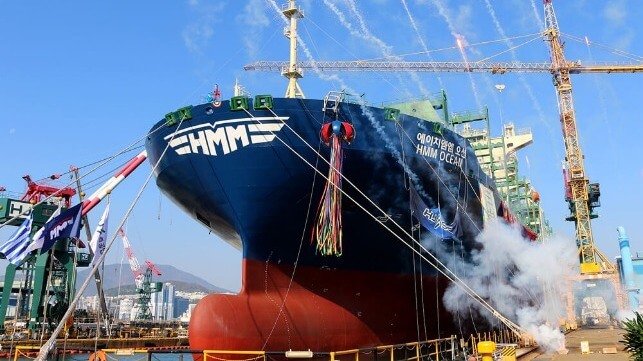
Shipping companies operating LNG-fueled vessels were part of an elite club that is continuing to grow and is now being cited as a fleet differentiator. South Korea’s HMM celebrated the name of its first two LNG-fueled containerships along with HJ Shipbuilding & Construction which called the vessels a key part of its re-entry into the commercial shipbuilding market.
The ceremony took place in Busan, South Korea at the HJ Shipbuilding yard on November 21. The two vessels, each with a capacity of 7,700 TEU are another example of the mid-sized segment converting to LNG following the large vessels which were among the first to adopt LNG.
HMM reports the ships, named HMM Ocean and HMM Sky, will enter service in January 2025. They will be deployed on its Far East-India-Mediterranean service. They will be both the first LNG containerships for the line and South Korea. HMM Ocean and HMM Sky are each 892 feet (272 meters) and are registered in Liberia.
The ships are part of a $240 million contract placed by Greece’s Navios Maritime Partners in 2022. HMM reports it has entered into a long-term charter for up to 14 years to operate the two vessels. They are part of the line’s efforts at further expansion and adopting alternative fuels. HMM also ordered in 2023 nine methanol-powered containerships to be built by HD Hyundai Heavy Industries and HJ Heavy Industries for delivery starting in 2026. HMM highlights that it plans to invest more than $10 billion to strengthen its eco-friendly competitiveness.
LNG has grown in popularity among shipowners as an available fuel option that will also permit future transitions to green fuels. Emerging just a decade ago, LNG continues to grow in adoption. DNV calculates that there are over 600 vessels worldwide now in service using LNG. This includes over 120 containerships with DNV calculating a further 300 LNG-fueled containerships are currently on order. LNG is only being challenged by methanol as the most common fuel type for new orders while Alphaliner calculated that 55 percent of the orders this year were for LNG dual-fuel vessels.
Zim, another mid-size operator, joined the LNG ranks in 2023 and is adding a total of 24 LNG vessels as part of a fleet construction program for a total of 46 vessels. Speaking to investors on its recent earnings call Zim cited the benefits of being an early adopter of LNG. They said it has provided both environmental and financial benefits, with LNG being 25 percent more efficient and consistently cheaper than LSFO. When Zim completes its new ship deliveries, 40 percent of its capacity will be on LNG-fueled vessels.
HMM’s president Kim Kyung-bae said during the naming ceremony that the new LNG vessels will be “a great help to HMM’s operations.”
HJ Shipbuilding highlights that it returned to commercial shipbuilding in 2021 due to the strong demand in the market and they are focusing on the 5,000 to 9,000 TEU midsized containership segment. They have also built six 5,500 TEU vessels and in June 2024 received an order from Navios for two 7,900 TEU vessels as well as an option for two more ships of the class.
